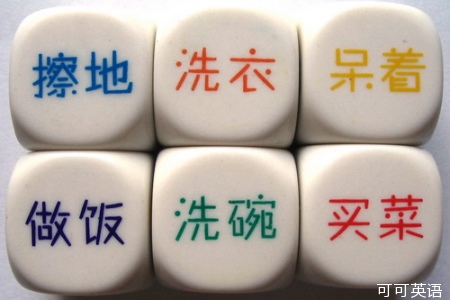(单词翻译:单击)

One reason so many American women are overweight may be that we are vacuuming and doing laundry less often, according to a new study that, while scrupulously even-handed, is likely to stir controversy and emotions.
一项新的研究显示,美国有如此之多的超重女性,原因之一是她们不再那么经常使用吸尘器和洗衣服。即使以谨慎而公正的方式进行,这项研究也可能在舆论和情感层面引起轩然大波。
The study, published this month in PLoS One, is a follow-up to an influential 2011 report which used data from the U.S. Bureau of Labor Statistics to determine that, during the past 50 years, most American workers began sitting down on the job. Physical activity at work, such as walking or lifting, almost vanished, according to the data, with workers now spending most of their time seated before a computer or talking on the phone. Consequently, the authors found, the average American worker was burning almost 150 fewer calories daily at work than his or her employed parents had, a change that had materially contributed to the rise in obesity during the same time frame, especially among men, the authors concluded.
上述研究成果是2011年发表的一篇论文的续作,刊登在本月的科研杂志《PLoS One》上。前作引起了很大反响,它通过美国劳工统计局(Bureau of Labor Statistics)的数据得出结论说,50年来,大多数美国劳动者逐渐开始坐着工作。像四处走动或搬运东西这样的体力劳动几乎已经消失。这些数据显示,现在劳动者把大多数时间都用在了操作电脑和打电话上。该论文的作者发现,和他们的父辈相比,美国劳动者每天在工作中消耗的热量减少了150大卡。作者断定,这样的变化对同一时期肥胖现象的增多有实质性的推动作用,特别是男性肥胖。
“Fifty years ago, a majority of women did not work outside of the home, ” said Edward Archer, a research fellow with the Arnold School of Public Health at the University of South Carolina in Columbia, and lead author of the new study.
哥伦比亚市南卡罗来那大学阿诺德公共健康学院(Arnold School of Public Health at University of South Carolina)研究员爱德华·阿彻(Edward Archer)博士是这篇新研究报告的主笔。他说:“50年前,多数女性都不外出工作。”
So, in collaboration with many of the authors of the earlier study of occupational physical activity, Dr. Archer set out to find data about how women had once spent their hours at home and whether and how their patterns of movement had changed over the years.
因此,阿彻博士联合了在之前的论文中探讨过职业体力劳动情况的多位作者,开始着手寻找过去女性在家中分配时间的数据,进而探究这些年来她们的行为模式是否改变以及出现了哪些变化。
He found the information he needed in the American Heritage Time Use Study, a remarkable archive of “time-use diaries” provided by thousands of women beginning in 1965. Because Dr. Archer wished to examine how women in a variety of circumstances spent their time around the house, he gathered diaries from both working and non-employed women, starting with those in 1965 and extending through 2010.
他在一项名为“美国时间分配研究资料库”(American Heritage Time Use Study, AHTUS)的研究中找到了自己需要的信息。AHTUS的课题是美国人怎样利用时间,它有一个非同凡响的数据库,其中收集了从1965年至今数千名美国女性的日记,内容是自己如何分配时间。由于阿彻博士希望了解不同条件下美国女性怎样在家里支配时间,所以他同时收集了职业女性和家庭主妇的日记,这些日记从1965年开始,一直延续到2010年。
He and his colleagues then pulled data from the diaries about how many hours the women were spending in various activities, how many calories they likely were expending in each of those tasks, and how the activities and associated energy expenditures changed over the years.
接下来,阿彻博士和同事们开始从这些日记中提取信息,以确定美国女性在各项家务上花费的时间、消耗的热量以及这么多年来这些家务和与之相关的能量消耗有了怎样的变化。
As it turned out, their findings broadly echoed those of the occupational time-use study. Women, they found, once had been quite physically active around the house, spending, in 1965, an average of 25.7 hours a week cleaning, cooking and doing laundry. Those activities, whatever their social freight, required the expenditure of considerable energy. (The authors did not include child care time in their calculations, since the women’s diary entries related to child care were inconsistent and often overlapped those of other activities.) In general at that time, working women devoted somewhat fewer hours to housework, while those not employed outside the home spent more.
最终,他们的发现和此前对劳动者如何分配时间的研究所得出的结论大体相同。以前,美国女性曾在家中从事相当多的体力劳动。在1965年,她们花在清扫、做饭和洗衣服上的时间平均为每周25.7个小时。无论借助怎样的工具,这些家务都会消耗相当多的能量。(研究者们没有把照看孩子的时间计算在内,原因是这些女性在照看孩子方面的记录存在矛盾而且经常和其他家务重叠在一起。)总的来说,当时职业女性在家务上花的时间较少,而家庭主妇在这方面所花的时间则较多。
Forty-five years later, in 2010, things had changed dramatically. By then, the time-use diaries showed, women were spending an average of 13.3 hours per week on housework.
45年后,也就是2010年,情况有了显著变化。上述日记显示,到2010年,美国女性花在家务上的时间平均为每周13.3小时。
More striking, the diary entries showed, women at home were now spending far more hours sitting in front of a screen. In 1965, women typically had spent about eight hours a week sitting and watching television. (Home computers weren’t invented yet.)
更引人注目的是,在这些日记中,家庭主妇坐在电视或电脑前的时间大幅上升。1965年,美国女性每周看电视的时间通常为八小时左右(当时还没有出现家用电脑)。
By 2010, those hours had more than doubled, to 16.5 hours per week. In essence, women had exchanged time spent in active pursuits, like vacuuming, for time spent being sedentary.
到了2010年,这个数字提高了一倍以上,达到每周16.5小时。实际上,美国女性压缩了用在清扫等动态行为上的时间,而延长了静坐不动的时间。
In the process, they had also greatly reduced the number of calories that they typically expended during their hours at home. According to the authors’ calculations, American women not employed outside the home were burning about 360 fewer calories every day in 2010 than they had in 1965, with working women burning about 132 fewer calories at home each day in 2010 than in 1965.
在这个过程中,她们在家里消耗的热量下降了很多。研究者们计算,2010年美国家庭主妇每天消耗的热量比1965年减少了360大卡左右,对职业女性来说,这个数字约为132大卡。
“Those are large reductions in energy expenditure, ” Dr. Archer said, and would result, over the years, in significant weight gain without reductions in caloric intake.
阿彻博士指出:“这在能量消耗方面是一个巨大退步。”如果不减少热量摄入,长此以往体重就会明显上升。
This does not mean, he said, that women — or men — should be doing more housework. For one thing, the effort involved is such activities today is less than it once was. Using modern, gliding vacuum cleaners is less taxing than struggling with the clunky, heavy machines once available, and thank goodness for that.
他说这并不意味着女性或男性应该分担更多家务。首先,现在做家务已不像从前那样耗费体力。谢天谢地,如今的吸尘器轻巧灵活,不像以前那样笨拙沉重,使用起来也不再那么费力。
Nor is more time spent helping around the house a guarantee of more activity, over all. A telling 2012 study of television viewing habits found that when men increased the number of hours they spent on housework, they also greatly increased the hours they spent sitting in front of the TV, presumably because it was there and beckoning.
其次,总的来说在家务上花更多时间并不能保证有更多的运动量。2012年一项关于看电视习惯的研究就生动地说明了这一点。这项研究表明,人们做家务的时间增多后,他们坐在那里看电视的时间也会大幅上升,原因大概是开着的电视引起了他们的注意。
Instead, Dr. Archer said, we should start consciously tracking what we do when we are at home and try to reduce the amount of time spent sitting. “Walk to the mailbox, ” he said. Chop vegetables in the kitchen. Play ball with your, or a neighbor’s, dog. Chivvy your spouse into helping you fold sheets. “The data clearly shows, ” Dr. Archer said, that even at home, we need to be in motion.
阿彻博士说,相反,人们待在家里时应该有意识地记录自己的活动并设法缩短坐着的时间。他建议说:“走到信箱那儿取信”,到厨房切菜,和自己或者邻居养的狗做游戏,哄爱人帮你一起叠床单。他指出,“这些数据清楚地表明”,就算在家,我们也需要动起来。


